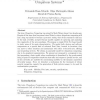Free Online Productivity Tools
i2Speak
i2Symbol
i2OCR
iTex2Img
iWeb2Print
iWeb2Shot
i2Type
iPdf2Split
iPdf2Merge
i2Bopomofo
i2Arabic
i2Style
i2Image
i2PDF
iLatex2Rtf
Sci2ools
ENTCS
2006
2006
Mobile Synchronizing Petri Nets: A Choreographic Approach for Coordination in Ubiquitous Systems
The term Ubiquitous Computing was coined by Mark Weiser almost two decades ago. Despite all the time that has passed since Weiser's vision, ubiquitous computing still has a long way ahead to become a pervasive reality. One of the reasons for this may be the lack of widely accepted formal models capable of capturing and analyzing the complexity of the new paradigm. We propose a simple Petri Net based model to study some of its main characteristics. We model both devices and software components as a special kind of coloured Petri Nets, located in locations, that can move to other locations and synchronize with other co-located nets, offering and requesting services. We obtain an amenable model for ubiquitous computing, due to its graphical representation. We present our proposal in a progressive way, first presenting a basic model where coordination is formalized by the synchronized firing of pairs of compatible transitions that offer and request a specific service, and ad hoc netw...
| Added | 12 Dec 2010 |
| Updated | 12 Dec 2010 |
| Type | Journal |
| Year | 2006 |
| Where | ENTCS |
| Authors | Fernando Rosa Velardo, Olga Marroquín Alonso, David de Frutos-Escrig |
Comments (0)

